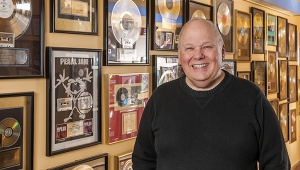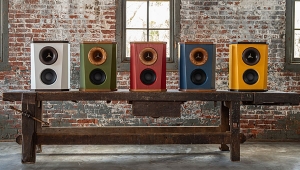| Columns Retired Columns & Blogs |
Paul McGowan: High-End Survivor Page 4
Atkinson: The Power Plant delivers a constant, regulated AC voltage to the components plugged into it, but the current waveform is still very irregular. I believe you're working on a PS Audio product using power-factor correction to address the fact that the current waveform is both nonsinusoidal and perhaps out of phase with the voltage waveform.
McGowan: Yes. As you saw when we monitored a device's current waveform with the Fluke meter, it drew current in a nonsinusoidal way. A power-factor correction device actually stores energy every cycle in an inductor. As the device suddenly demands current, the power-factor corrector provides energy that it has stored. It changes the instantaneous current demand into a more sinusoidal form, which results in a much smoother ripple voltage on the device's power supply.
One of the things that we have found that dramatically change the way things sound is the amount of power-supply ripple. It seems to be directly related. Right now we do that by changing the frequency of the Power Plant's output voltage. We're providing a stable, regulated, low-distortion AC source, but because we're generating that source with a sinewave oscillator, we can control the frequency. On the front of the Power Plant is a button that allows you to raise the frequency from 50Hz to 120Hz in 5Hz increments. There are two advantages in raising the frequency: lower power-supply ripple and higher overall average voltage coming out of the raw power supply. In either case, the [power-supply output] gets closer to DC when you bounce it up to 120 cycles.
Atkinson: I'm having difficulty trying to visualize what's going on with a power-factor corrector. If you have a power amplifier that is playing some large-scale, current-demanding music, its power-supply capacitors are going to want to suck their replenishing charge out of the wall. But if you have the amplifier plugged into something that is trying to smooth out those rushes, aren't you going to starve those transients of current?
McGowan: Not if you build it properly and tailor it to the load. The first [power-factor corrector] we're going to come out with is a smaller one that will be able to do 100 watts. But you bring up a good point, because if it is passive, there will be a point of current draw that it will be best at. If you draw too little current or you draw too much current, it won't be quite as good. There'll be a bell curve.
Atkinson: So it is very important to use a device that's best matched to the load.
McGowan: For power amplifiers we'll produce 1000W devices and 500W devices, and obviously the magnetics in those get larger. But there'll be a bit of education involved. Audiophiles will say, "Jeez, if I need a 50-horsepower engine on my car and I hook up 500, I'll be in good shape." It's not quite the same thing.
However, the truth of the matter is that within its power curve—from 100mA to 1A, say—somewhere along that curve you'll have the lowest "current distortion." But at any point along the curve it will probably be on the order of 10 to 20 times better than not having the device in the first place.
My transformer manufacturer, Sergio at Mercury Magnetics, and I have been actually trying to figure out for a few years how to do such a thing. We have completely failed. But a guy named Ron Lesea, who has been in the power-conditioning business for ever, has actually patented such a device (along with Steve Smith). PS Audio has acquired the exclusive rights to these devices for the video and audio markets.
Atkinson: You recommend in the Power Plant's manual that owners should experiment with power cords. This is something that baffles non-audiophiles—that AC cords can affect sound quality.
McGowan: Even if you take the output of a Power Plant and you have a perfect 0.05% distortion waveform sourced from quite a low impedance, you're then hooking this 6' antenna onto it. You're taking a step backwards, because even in the average home we have computers, cell phones, all kinds of radiating devices that can be picked up by that antenna. So once you get the AC waveform feeding your power amplifier correctly, you want to be able to isolate that AC from this nasty outside environment.
I've done a lot of work with cables over the years. Two factors I've found that are critical are a great deal of shielding and a lot of copper surface area. If you look at what people are doing in the telecommunications industry, they're basically using what's called a triaxial cable—a three-shield coax. If you try that for audio, it has great shielding but there's not a lot of surface area, so the sound turns out rather "thin."
So for our Lab Cable, which is 1" thick but still very flexible, basically we took a 6-gauge, 1057-strand conductor and triple-shielded it, then did a special jacket. We double-shielded both conductors and put a single shield over the whole thing. There's nothing real magic about it—actually, the magic was getting it manufactured.
Atkinson: In August you'll be introducing solid-state power amplifiers housed in the same chassis as the Power Plants. Although Stereophile is supposed to be exclusively concerned with sound quality, the new PS Audio's industrial designs are stunning, at least in my opinion. Who does that work for you?
McGowan: Alex Rasmussen from Neal Feay. He did Wadia and Faroudja and Class/. Alex, in my opinion, is the most brilliant industrial designer out there. The only competition he has is the guy at [Mark] Levinson . . .
Atkinson: Is there anything different about these amplifier designs?
- Log in or register to post comments




































